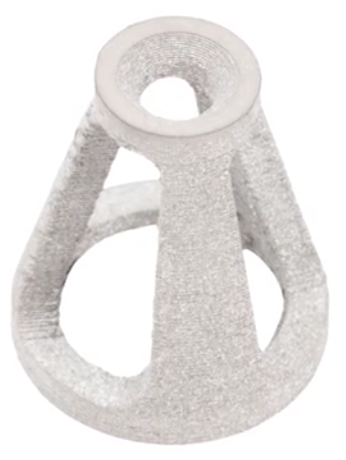
Today we will take a look at Desktop Metal’s newest material, Ti64 titanium. It’s one of the most commonly used titanium alloys and Ti64 has excellent strength, low modulus of elasticity, high corrosion resistance, good weldability, and is heat treatable. It also has a high temperature resistance and the ability to withstand temperatures of nearly 800°C.

Ti64 is used in a variety of industrial applications, where low density and excellent corrosion resistance are necessary, such as; aerospace, marine, power generation, and offshore oil and gas. It is also used in specialty automotive, medical device prototypes, and consumer goods.
With traditional manufacturing, titanium is not cheap and it is notoriously difficult to machine. Machined parts will typically start with a large billet and a lot of material might have to be removed to produce a part. Hence little mistakes can be costly.
With 3D printing that waste is all but eliminated resulting in significant savings. However, this material is not new to metal 3D printing. Due to its reactive nature, it can pose certain health and safety concerns when processed on laser-based powder bed fusion technology, which can lead to facility requirements that are expensive or prohibitive.
Whereas 3D printing Ti64 titanium on Desktop Metal’s Studio System eliminates those expensive facility requirements because the metal powder has already been mixed with plastic & wax and is completely encapsulated, thus opening up a new level of design freedom.

Through Bound Metal Deposition, you can create titanium parts with complex features not possible with traditional methods, including internal channels, thin ribs, and lattices. It also offers exceptional material properties.

In the helicopter fixturing bracket shown below, the part was redesigned to reduce weight while maintaining functional strength and stiffness. The Studio system allowed for the organic gyroid lattice infill, resulting in a weight reduction of 30%.

The Fuel Injector Nozzle sample part below is an aerospace part responsible for driving fuel into a burner for propulsion. This nozzle features internal channels that can result in enhanced burner performance. Titanium is essential for this application because it allows the nozzles to be light – just 19.3g – while still being able to withstand extreme temperatures and pressures.
With the Studio System 2, engineers were able to print and test four iterations of this part in just 24 hours, helping to identify the optimal design.
As you can see, 3D Printing with titanium grants engineers the freedom to develop new and innovative metal parts, in a safer and more cost-effective way.
Download the Material Data Sheet below.







Leave A Comment